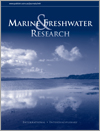Marine and Freshwater Research
Volume 72
Number 1 2021
Over 100 citizen scientists volunteered more than 10 000 h to assess the health of a subtropical reef situated in a ‘Hope Spot’ for corals using Reef Check Australia and CoralWatch methods. They also produced the first ever detailed habitat map of the reef on the basis of underwater photos and satellite imagery. Results showed that the reef is in a healthy condition and recommended to management doubling the current green zone for a better protection and conservation.
The population dynamics of the American crocodile in Paramillo National Natural Park were analysed with population projection matrices to characterise its conservation status. Despite the apparent stability of this population, we suggest that it be considered a key target for future conservation efforts.
We evaluated the spatial variation of the ostracod resting eggs between the centre and edge areas of temporary lakes of a tropical flood plain. The abundance and species composition were similar between the regions of the lakes. Flood events may be responsible for the homogenisation of egg banks.
We determined the genetic diversity and population genetic structure of O. hubbsorum by using mtDNA sequences (COI and ND5). The population structure was not supported by AMOVA or a spatial clustering model. Three haplogroups were detected using a Bayesian assignment; however, the distribution of these haplogroups did not differ among the sampling sites. Our results indicated historical processes of a sudden population expansion, as has been reported for other species in the study region as consequence of climatic changes.
Freshwater ecosystems, including rivers, are environments potentially vulnerable to exotic invertebrates. The present study identified the unexpected occurrence of several divergent lineages of a semiaquatic oligochaete earthworm (Eiseniella tetraedra) in Iranian freshwater tributaries, potentially introduced through human activities. The relative abundance of lineages may indicate a significant decline in the abundance of native oligochaetes.
Recycled concrete materials are becoming very popular as a building material throughout the world. However, the recycled concrete may be used where it is immersed by water. This research shows that this can quickly generate polluted water. The nature of the pollution includes salinity, pH and metals. The contaminated water may be hazardous for aquatic species. The recycled concrete needs to be used carefully, considering its potential to pollute waterways and damage aquatic ecosystems.
Bali, Indonesia, has a productive small-scale crafts industry and intensive small-scale agriculture and aquaculture. Concentrations of contaminants were determined in soils from various small-scale industries along with sediments from aquatic systems. Concentration of zinc in solid waste collected from batik production (i.e. fabric dyeing operations) was above guideline values and batik production contained elevated concentrations of other contaminants. Lake sediments were enriched with phosphorus and nitrogen, likely from agricultural runoff. This baseline information highlights the value of lake-protection measures in place, and provides focus for improving the management of contaminant sources.
Rhodoliths are ‘ecosystem engineers’ that underpin habitats considered as ‘hot spots’ of biodiversity. We studied how environmental variation associated with depth and seasonality influence the diversity, structure and abundance of associated amphipods. We demonstrated that the ecological pattern of amphipods associated with rhodoliths can vary greatly across both time (seasons) and space (depth).
The Macrobrachium jelskii species is a prawn in Brazilian semiarid rivers. The relations with modern and past events in its populations have curious questions about distribution. The ‘morphology-shape scan’ shows differences between sexes in the abdominal region, no differences related with river velocity and little differences among river populations. These results indicated a probable non-natural distribution of this prawn.
This work estimated growth and mortality rates and undertook a stock assessment of red lobster caught on the Amazon coast. The lobsters on the Amazon coast are slow growing and have a high asymptotic maximum length, with ages up to 21.37 years. Although fishing acted mostly on adults, the exploitation rate was closer to the value recommended for precautionary policies. Regulation measures should be implemented because increased fishing effort is expected.
Critically endangered great hammerhead sharks from Saudi Arabian waters of the Arabian Gulf were collected for reproduction and growth studies via observation of sex organ and vertebrae analysis. The sharks are suspected to give birth during May and June, and a breeding ground may be present in the Arabian Gulf. This study provides the first life history of great hammerhead sharks in the north-western Indian Ocean.
In this study we analysed temporal trends of abundance and investigated the distribution and biological features of the data-deficient shark (Squalus blainville) in the central western Mediterranean, where information is lacking. The documented decline and low reproductive potential of this shark (late size at maternity, low fecundity, long reproductive cycle and coexistence of juveniles and mature adults at the same depths) calls for the establishment of protection plans for the western Mediterranean population of S. blainville.
We examined DNA markers, which are effective tools for identifying population genetic units, to report the first genetic characterisation of the endangered and commercially exploited spiny dogfish in the Adriatic Sea. The findings suggest that the Adriatic subpopulation has an Atlantic–South Pacific origin and that it is mainly isolated from Atlantic stocks and should be considered a separate management unit when implementing protective management plans.
Increasing water temperature has been suggested to result in enhanced recruitment of the boarfish Capros aper, one of the most discarded non-commercial species in the north-east Atlantic. Its increasing abundance justified a new fishery, but the reproductive strategy of the species is far from being understood. This study determined fecundity type and its estimation, supported by an investigation of sex steroid profiles.
 , Julie Vercelloni, Tania M. Kenyon, Elisa Bayraktarov, Cedric P. van den Berg, Daniel Harris, Jennifer A. Loder, Morana Mihaljevic, Phebe I. Rowland and Chris M. Roelfsema
, Julie Vercelloni, Tania M. Kenyon, Elisa Bayraktarov, Cedric P. van den Berg, Daniel Harris, Jennifer A. Loder, Morana Mihaljevic, Phebe I. Rowland and Chris M. Roelfsema




